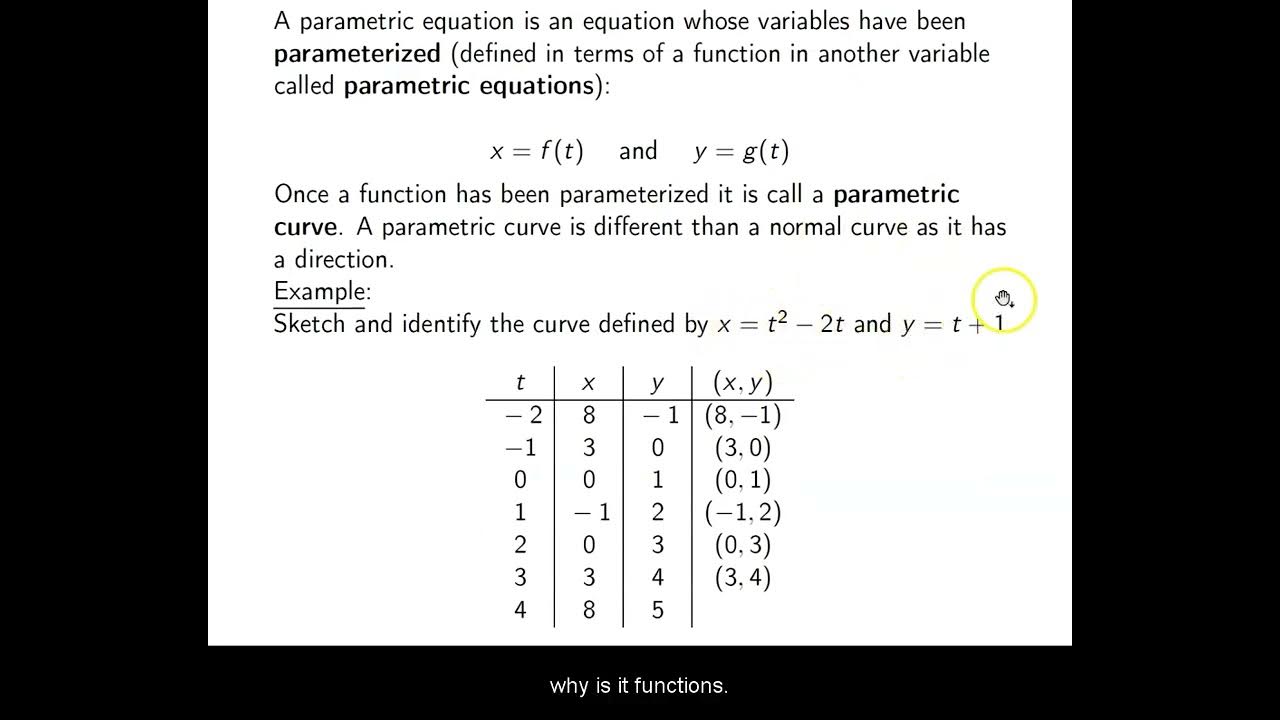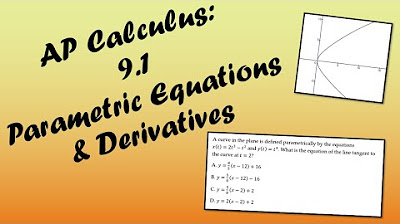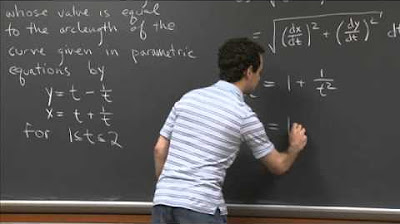Parametric Equations
TLDRThe script discusses parametric equations, where X and Y are calculated separately based on a third parameter T, often time. This is useful for modeling projectile motion, where horizontal and vertical velocities change independently. An example is given using X=2T and Y=T^2. By plugging in T values, plotting points, and eliminating T, we can graph and derive the equation of the resulting parabola. Parametric equations can be easier to visualize or graph, but converting to rectangular coordinates helps connect the approaches. The goal is comprehending translations between coordinate system types.
Takeaways
- 😀 Parametric equations express X and Y in terms of another variable (usually time)
- 😲 They are useful for modeling motion, where X and Y change independently
- 💡 Example is projectile motion, where horizontal and vertical velocities are independent
- 📏 Set up parametric equations as X=f(T) and Y=g(T) for some parameter T
- 📊 Plug in values for T to generate x,y coordinate pairs to plot the curve
- 🔢 Can eliminate the parameter to get a standard equation for the curve too
- 🖥 Parametric equations can be easier to graph on a calculator
- 🤔 Choosing between parametric and rectangular depends on the situation
- ✏️ Key is understanding how to move between the two forms
- 🧠 Check comprehension on using both types of equations
Q & A
What are parametric equations?
-Parametric equations are sets of equations in which the X and Y values are calculated in separate equations, and each dependent on some other variable, usually time.
Why are parametric equations useful for modeling projectile motion?
-In projectile motion, the horizontal and vertical positions change independently over time due to constant horizontal velocity and vertically accelerating motion under gravity. Parametric equations allow separate equations for X and Y positions in terms of time.
How do you graph a plane curve from a set of parametric equations?
-Plug in some values for the parameter T, calculate the corresponding X and Y values to get points, plot those points, and connect them to get the curve.
What is eliminating the variable in parametric equations?
-It means solving one parametric equation for the parameter T and substituting it into the other equation to eliminate T and get an equation relating only X and Y.
When might parametric equations be easier to use than rectangular equations?
-Graphing calculators can handle parametric equations for some curves like ellipses more easily. Parametric equations can also be easier when X and Y motion need to be modeled separately.
If X = 2T and Y = T^2, what are the parametric equations for the resulting parabola after eliminating T?
-Solving the first equation for T = X/2 and substituting into the second gives Y = (X/2)^2 = X^2/4. So the single equation is Y = X^2/4.
What is the key difference between rectangular and parametric equations of curves?
-Rectangular equations directly express Y as a function of X. Parametric equations express both X and Y as functions of an independent parameter like time.
Why does eliminating the parameter sometimes help in graphing parametric curves?
-After eliminating the parameter, you have a single equation y=f(x) that can be graphed easily using typical rectangular coordinate methods.
What are some examples of real-world applications of parametric equations?
-Modeling projectile motion, orbits of planets, modeling biological growth rates, mixing chemicals at varying rates, etc. Any system with interdependent variable rates of change.
What are the main advantages of the parametric equation representation over rectangular coordinates?
-The ability to model coupled variable motions separately, ease of graphing some curves, and insight into rate of change relationships between variables.
Outlines
😀 Introducing Parametric Equations
This paragraph introduces the concept of parametric equations, where X and Y values are calculated separately using different equations that depend on a third parameter T, often representing time. Common applications include modeling projectile motion, where horizontal and vertical velocities change independently. An example is provided using equations X=2T and Y=T^2, which are plotted and then eliminated to find the single equation for the resulting parabola.
Mindmap
Keywords
💡parametric equations
💡projectile motion
💡eliminating the variable
💡graphing calculator
💡ellipse
💡parameter
💡rectangular form
💡horizontal velocity
💡vertical velocity
💡wind resistance
Highlights
Parametric equations express X and Y in terms of another variable, often time
Parametric equations are useful for modeling projectile motion, where horizontal and vertical velocities change independently
With parametric equations for projectile motion, X position depends on time differently than Y position does
Parametric equations let you model X and Y independently as functions of a parameter like time
To graph parametric equations, make a table of parameter values and plot the corresponding X and Y points
Example parametric equations for a parabola, with parameter T: X=2T, Y=T^2
Can eliminate the parameter to get a regular cartesian equation from parametric equations
Parametric equations can be easier to graph on a calculator compared to cartesian form
Parametric equations are useful for representing some curves, like ellipses
Need to understand both parametric and cartesian forms of equations
X and Y motion in projectiles is independent, so parametric equations make sense
Parametric equations have X and Y as separate functions of a parameter like time
Plot parametric equations by making a table of parameter values and finding X and Y
Can eliminate parameter from parametric equations to get cartesian equation
Parametric equations can simplify graphing some curves on a calculator
Transcripts
Browse More Related Video

Ch. 8.4 Plane Curves and Parametric Equations

AP Calculus BC Lesson 9.1

Parametric equations 3 | Parametric equations and polar coordinates | Precalculus | Khan Academy

Parametric equations 2 | Parametric equations and polar coordinates | Precalculus | Khan Academy

Lesson 10 - Parametric Equations (Calculus 2 Tutor)

Parametric Arclength | MIT 18.01SC Single Variable Calculus, Fall 2010
5.0 / 5 (0 votes)
Thanks for rating: